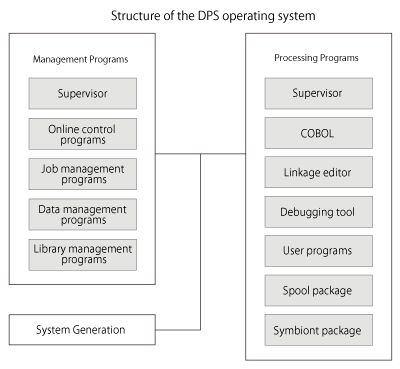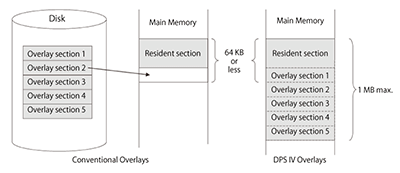The MELCOM 80 Model 31, announced in 1974, was the first Mitsubishi Electric office computer to have an operating system. The Model 31 came with AOS (which stood for “All-round Operating System”), a single-task operating system. Later, Mitsubishi Electric developed DPS (“Dynamic Processing System”), a multitask version of AOS, for the Model 38, which was announced in 1977. In this way, either AOS or DPS could be selected to match the machine’s configuration. Both had 16-bit architectures. The operating systems consisted of three main components: processing programs, management programs, and system generation.

- Home >
- Historical Computers in Japan >
- Office Computer OS >
- AOS,DPS
【Mitsubishi Electric】 AOS,DPS

- (1) Job management programs
- Although DPS did not have the concept of a virtual memory space, it was able to simultaneously execute three different types of processing (batch processing, online or inline processing, and spool or symbiont processing) by dividing the 64-kilobyte physical memory space into utmost three partitions. For online or inline processing, multiple programs could be run simultaneously by swapping them in and out of memory.
Spool jobs copied I/O data for batch jobs between low-speed I/O devices — such as card readers, line printers, and paper tape reader-writers — and magnetic tape units. Spool jobs reduced the wait time for inputs and outputs when executing batch jobs because I/O operations took place with the relatively fast magnetic tape unit instead of with a low-speed I/O device. Symbiont jobs, on the other hand, wrote data intended for a low-speed output device like a line printer to a disk instead of outputting the data directly. The actual printing took place while the computer was idle. Both spool jobs and symbiont jobs were designed to improve the computer’s utilization efficiency and maximize system throughput.

- (2) Data management programs
- Data management programs took care of the management of disk volumes and files stored on disk volumes. These programs allocated file space at file creation and provided exclusive control over file access. It was possible to create data files in one of four organizations — sequential files, relative (direct) files, indexed files, and multiple-indexed files.
- DPSII
- DPS II was introduced with MELCOM 80 models 18 and 28, which were announced in 1978, and it incorporated a virtual memory space concept. Full-fledged multitask processing was realized by using the first four kilobytes of the 64-kilobyte logical memory space as a common space and the remaining 60 kilobytes as a virtual space for each program. This feature enabled simultaneous processing by up to 32 consoles. DPS II also came with Progress II, an improved version of Progress a simplified programming language.
- DPSIII
- The MELCOM 80 Model 18, 28, 38, and 48 Japanese Language series of office computers, which were announced in 1980, were the first to support terminals that could display and print 24 x 24-dot characters. DPS III, which was developed for the MELCOM 80 Japanese Language series, came with powerful Japanese data processing functions.
DPS III had the following five features. - (1) Operation in Japanese
- Japanese job menus could be made for faster comprehension and operation, and jobs could be selected with a single function key. Inquiries on error handling with the system status key, and interactive operations with utility programs were also available.
- (2) Functions for processing Japanese data
- The Progress II programming language made it possible to automatically add or delete shift codes between two-byte characters and one-byte characters, as well as automatically adjust the alignment of columns when Japanese data were written on a screen or a form. In addition to a kana-kanji conversion function, DPS III was standard equipped with a number of Japanese language utility programs and sub-systems, such as a company-name sorting program that ignored appellations like “Limited” or “Corporation” when sorting company names.
- (3) Japanese dictionary library
- The database-structured Japanese dictionary library provided fast access to various words and compounds and allowed users to add and delete entries.
- (4) Kanji character sets and external characters
- DPS III could handle up to 35,000 characters including all JIS Level 1 and Level 2 kanji characters along with special marks, such as kg or cm in one character, that were not defined by JIS. There was also a function for adding user-defined characters by creating and registering font patterns.
- (5) Japanese processing performance
- DPS III was distinctive in that all the Japanese processing added to it did not result in any deterioration in the operating system’s multi-terminal processing performance.
- DPSIV
- DPS IV was the successor to DPS III and was first shipped in October 1982 as the operating system for the MELCOM 80 Model 48B. With DPS IV, the program execution space was expanded to one megabyte. Most 16-bit machines at the time had a 64-Kbyte restriction on the logical memory space one program could use. DPS IV, however, realized three improvements that made it possible to run larger applications.
DPS III was constructed so that the macro functions and I/O buffers used for file processing and other runtime subroutines were all included in one logical space with the application program. The first DPS IV improvement was the creation of an architecture to place these macro functions, buffers, and subroutines outside of the application program’s logical space. This method made it possible to develop programs that were on average 20 Kbytes larger than before.
The second improvement in DPS IV involved an upgrade to the overlay manager that allowed overlay in main memory. Overlay is a technique in which a program’s code is divided into one resident section and several non-resident overlay sections. The overlay sections were usually stored on a disk and were loaded and executed as necessary in the free space not occupied by the resident section in the logical memory space. Because this technique accessed the disk each time an overlay section was switched, it could not be employed in certain cases if the application program required high performance levels. With DPS IV, however, overlay sections could be placed in main memory up to the one megabyte maximum, overcoming the 64-Kbyte logical space restriction. As a result, overlay programs did not require disk access. The diagram below illustrates the difference between the two techniques.

- The third improvement, a program-linking method, essentially did away with restrictions on program execution space by treating subroutines as single, independent programs and enabling the main program to call these programs as needed.
These improvements greatly alleviated the hardships of application programmers who were struggling against the 64-Kbyte barrier. DPS IV also offered dramatically better disk performance with a form of disk cache that kept the index section of indexed files and multi-indexed files resident in main memory.
All Rights Reserved, Copyright (C) Information Processing Society of Japan
